|
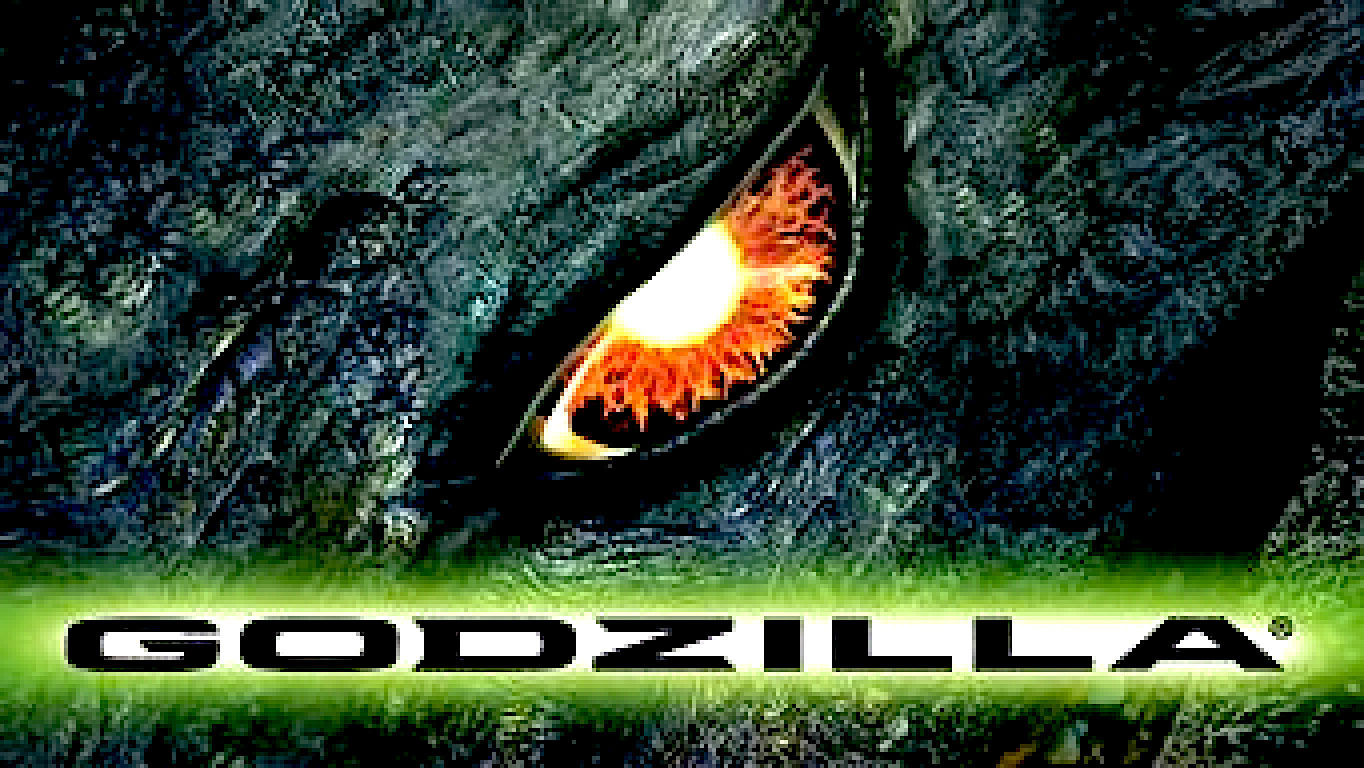
The
eye of the monster lizard
Godzilla is a 1998 American monster film directed and co-written by Roland Emmerich. Produced by Centropolis Entertainment, Fried Films, and Independent Pictures, and distributed by
TriStar
Pictures, it is a reboot of Toho Co., Ltd.'s Godzilla franchise. It is also the 23rd film in the franchise and the first Godzilla film to be completely produced by a Hollywood studio. The film stars Matthew Broderick, Jean Reno, Maria Pitillo, Hank Azaria, Kevin Dunn, Michael Lerner, and Harry Shearer. The film is dedicated to Tomoyuki Tanaka, the co-creator and producer of various Godzilla films, who died in April 1997. In the film, authorities investigate and battle a giant monster who migrates to New York City to nest its young.
In October 1992, TriStar announced plans to produce a trilogy of Godzilla films. In May 1993, Ted Elliott and Terry Rossio were hired to write the script. In July 1994, Jan de Bont was announced as the director but left the project that December due to budget disputes. Emmerich was hired in May 1996 to direct and co-write a new script with producer Dean Devlin. Principal photography began in May 1997 and ended in September 1997.
Godzilla was theatrically released on May 20, 1998, to negative reviews and grossed $379 million worldwide against a production budget between $130–150 million and marketing costs of $80 million. Despite turning a profit, it was considered a box office disappointment. Planned sequels were cancelled and an animated series was produced instead.
TriStar let their remake/sequel rights expire on May 20, 2003. In 2004, Toho began trademarking new iterations of TriStar's Godzilla as "Zilla", with only the incarnations from the 1998 film and animated show retaining the Godzilla copyright/trademark.
THE PLOT
An iguana nest is exposed to the fallout of a military nuclear test in French Polynesia. In the South
Pacific
Ocean, a Japanese cannery vessel is suddenly attacked by a giant creature, with only one fisherman surviving. Dr. Niko "Nick" Tatopoulos, an NRC scientist, is in the Chernobyl exclusion zone researching the effects of radiation on wildlife, but is interrupted by an official from the U.S. State Department. Meanwhile, in
Tahiti, a mysterious Frenchman questions the traumatized survivor over what he witnessed, who repeatedly replies "Gojira." Nick is sent to Panama and Jamaica to study a trail of wreckage leading to another cannery ship with massive claw marks on it. Nick identifies skin samples he discovered in the shipwreck as belonging to an unknown species. He dismisses the military's theory of the creature being a living dinosaur, instead deducing it is a mutant created by nuclear testing.
The creature travels to New York City, leaving a path of destruction in its wake. The city is evacuated before the U.S. military, on Nick's advice, lure the creature into revealing itself with a large pile of fish. Their attempt to kill it fails, however, and only causes further damage before it escapes. Nick collects a blood sample, and by performing a pregnancy test, discovers the creature reproduces asexually and so is collecting food for its offspring. Nick also meets up with his ex-girlfriend, Audrey Timmonds, a young aspiring news reporter. While she visits him, she uncovers a classified tape in his provisional military tent concerning the monster's origins and turns it over to the media. She hopes to have her report put on TV as to launch her career, but her boss, Charles Caiman, uses the tape in his report, declaring it his own discovery, and dubs the creature "Godzilla."
As a result, Nick is removed from the operation and he disowns Audrey, before being kidnapped by the mysterious Frenchman Philippe Roaché. Revealing himself as an agent of the French secret service, Philippe explains that he and his colleagues have been closely watching the events to cover up their country's role in the nuclear testing that created Godzilla. Suspecting a nest somewhere in the city, they cooperate with Nick to trace and destroy it. Meanwhile, Godzilla resurfaces and dives into the Hudson River to evade a second attempt by the military to kill it, where it is attacked by Navy
submarines. After colliding with torpedoes, Godzilla sinks, believed to be dead by the authorities.
Nick and Philippe's team, followed by Audrey and her cameraman Victor "Animal" Palotti, find the nest inside Madison Square Garden, with over 200 eggs. Before long, the eggs begin to hatch and the strike team are attacked by the offspring. Nick, Animal, Audrey and Philippe take refuge in the Garden's broadcast booth and successfully send out a live news-report to alert the military. A prompt response involving an airstrike is initiated as the four escape moments before the Air Force bomb the arena.
Audrey and Nick reconcile, before the adult Godzilla, having survived, emerges from the Garden's ruins. Enraged by the deaths of its brood, it takes its rage out on the four, chasing them across Manhattan. After a taxi chase, they manage to trap Godzilla within the cables of the Brooklyn Bridge, allowing the returning Air Force to shoot it. Godzilla dies from its mortal wounds, and the remaining citizens and authorities celebrate. Audrey tells Caiman that she quits working for him after what he has done, before leaving with Nick. Philippe, taking a tape Animal was recording and promising to return it after removing certain contents, thanks Nick for his help and parts ways. Meanwhile, in the ruins of Madison Square Garden, a single surviving egg hatches and the hatchling roars.
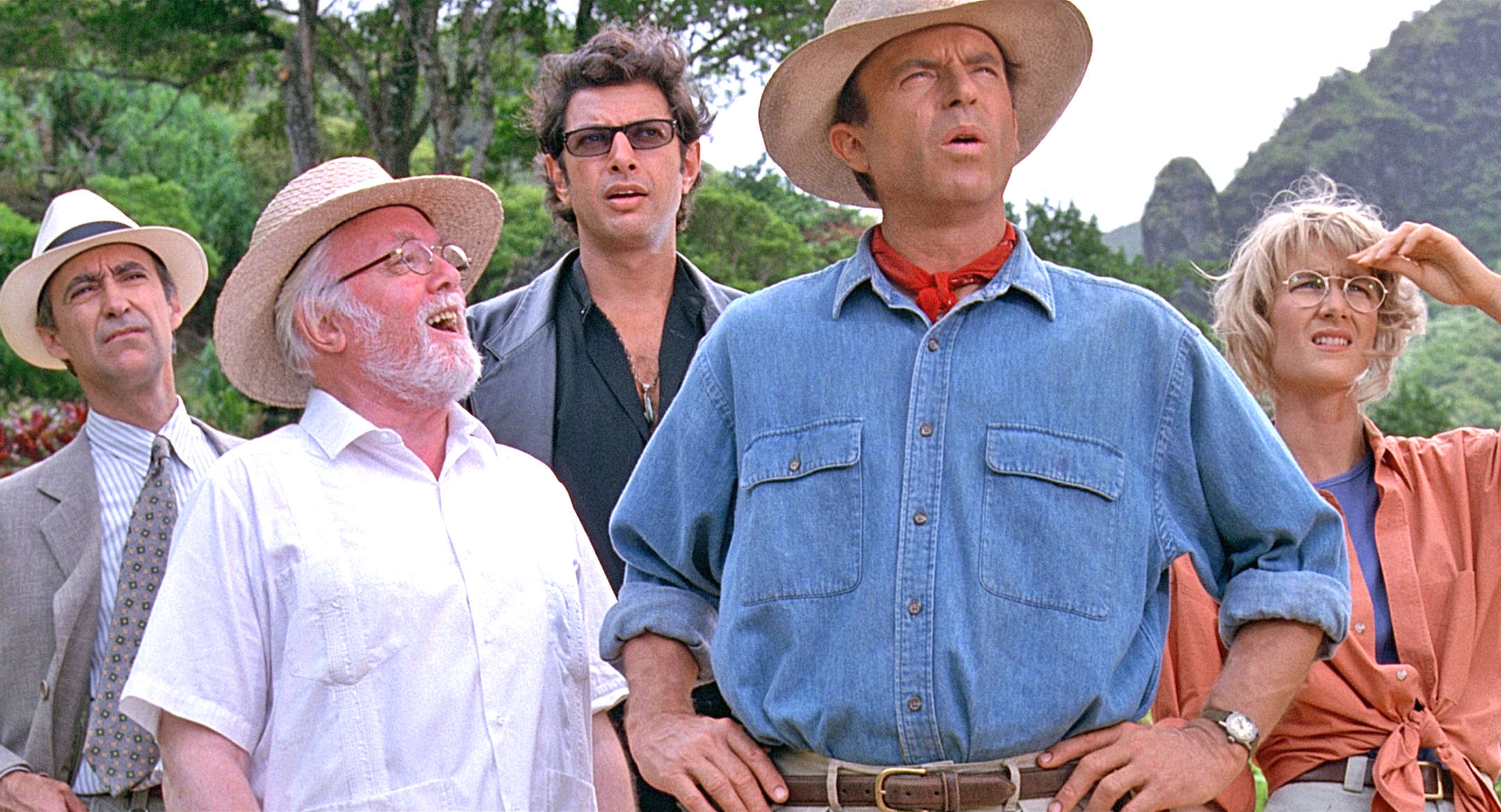
Richard
Attenborough as John Hammond, to Sam Neil as Alan Grant:
"It's right up your alley."
PRODUCTION & DEVELOPMENT
American film producer and distributor Henry G. Saperstein (who had co-produced and distributed past Godzilla films for the American market through his studio UPA) received permission from Toho Co., Ltd. to pitch a new Godzilla film to Hollywood studios, stating, "For ten years I pressured Toho to make one in America. Finally they agreed." Saperstein initially met with Sony Pictures producers Cary Woods and Robert N. Fried for discussions regarding a live-action Mr. Magoo film but the discussions led to the availability of the rights to Godzilla.
Interested, Woods and Fried proposed the idea to Columbia
Pictures, but were initially rejected. Woods stated, "We pitched the idea to Columbia and they passed outright. Their response was they felt it had the potential for camp". The two also tried to pitch the idea to TriStar Pictures but were also shot down, Fried stated, "TriStar did originally pass on the project. The people who were running the studio at that particular time may not have seen commercial potential there, may not have thought that it would make a great film."
Taking advice from his wife, Woods instead went over the executives' heads and proposed the idea to Peter Guber, the then-chairman of the board and CEO of Sony Pictures. Guber became enthusiastic about the idea, seeing Godzilla as an "international brand" and set the film up at TriStar. Woods recalled, "Peter got it; he saw the movie in his head. He was like, 'Godzilla, the fire-breathing monster?! Yesss!'" TriStar vice-chairman Ken Lemberger was sent to Tokyo to oversee the deal in obtaining the Godzilla rights from Toho in mid-1992. Sony's initial offer included a $300,000
- 400,000 advance payment with an annual licensing fee for the Godzilla character, as well as production bonuses, exclusive distribution and merchandising rights for Japan, a profit percentage from international ticket sales and merchandising, usage rights to some of the monsters from the first 15 Godzilla films, and allow Toho to continue producing domestic Godzilla films while TriStar developed their film. Sequentially, Toho sent Sony a document of rules on how to treat Godzilla. Robert Fried stated, "They even sent me a four-page, single-spaced memo describing the physical requirements the Godzilla in our film had to have. They're very protective."
In October 1992, TriStar formally announced their acquisition of the rights to Godzilla from Toho to produce a trilogy of Godzilla films, with the promise of "remaining true to the original
series - cautioning against nuclear weapons and runaway technology." After TriStar's announcement, many of the original Godzilla filmmakers expressed support for the film; Haruo Nakajima (who portrayed Godzilla from 1954 to 1972) stated, "I'm pleased. I hope that a competition will spring up between Toho and TriStar," Koichi Kawakita (special effects director of the Heisei Godzilla films) stated, "I have great expectations. I'm looking forward to seeing it, not only because I direct special effects for Godzilla films but also because I am a movie fan," Teruyoshi Nakano (special effects director of the late Showa Godzilla films) stated, "I'm pleased that a new approach will be taken", and Ishirō Honda (director of various Showa Godzilla films) stated, "It will probably be much more interesting than the ones [currently] being produced in Japan."
In 1994, Jan de Bont became attached to direct and began pre-production on the film for a 1996 summer release. De Bont's Godzilla would have discarded the character's atomic origin and replaced it with one wherein Godzilla is an artificial creation constructed by Atlantians to defend humanity against a shape-shifting extraterrestrial monster called "The Gryphon". Stan Winston and his company were employed to do the effects for the film. Winston crafted sculptures of Godzilla and The Gryphon. De Bont later left the project in December 1994 after TriStar refused to approve his budget of $100–120 million. He would later go on to direct Twister and Speed 2: Cruise Control. Clive Barker and Tim Burton were also in talks to potentially direct.
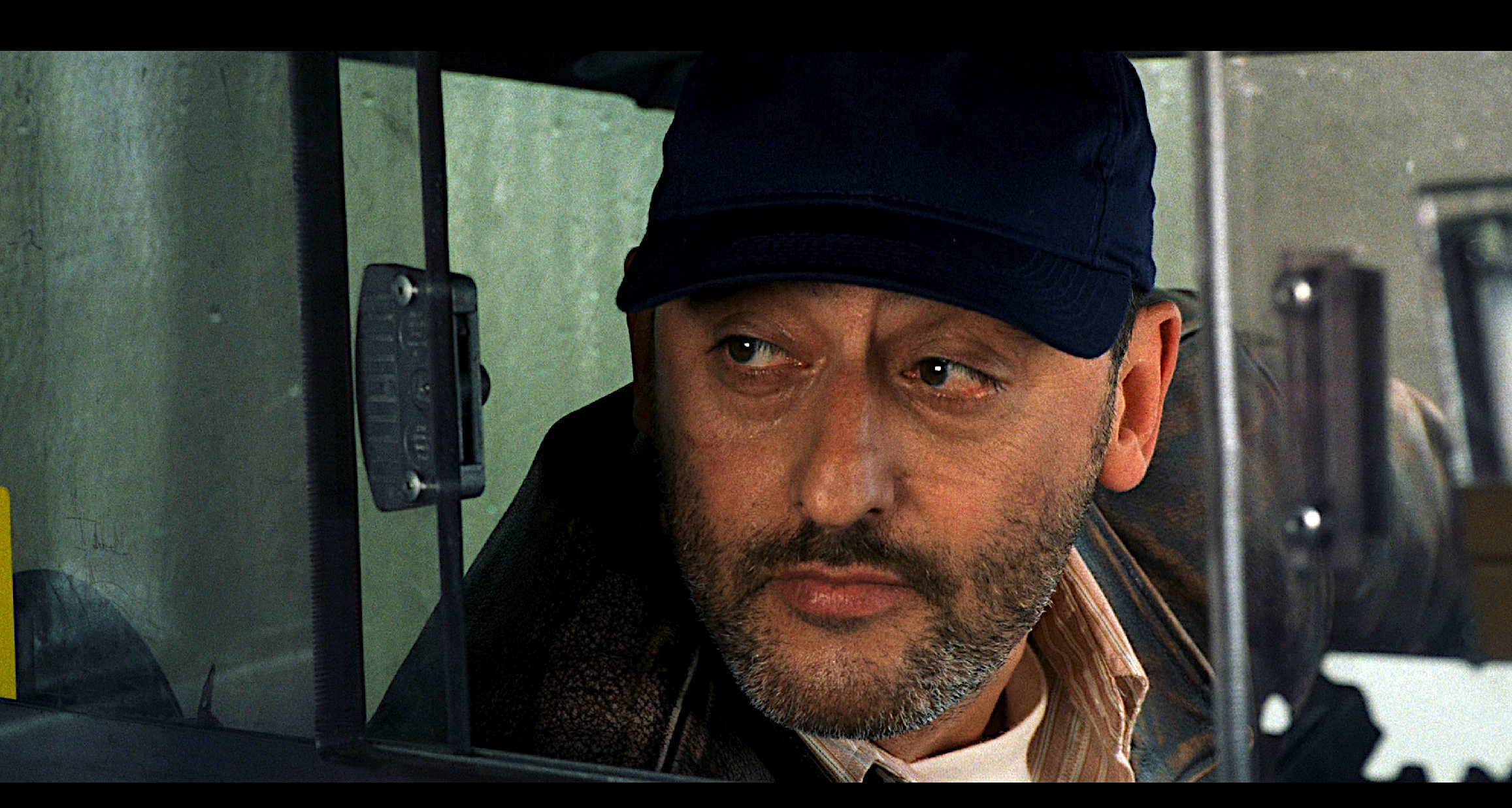
Jean
Reno brings something to the table
ELLIOT AND ROSSIO SCRIPT
In May 1993, Ted Elliott and Terry Rossio were hired to write the screenplay. Prior to their hiring, Elliott and Rossio were searching for their next project and were offered Godzilla by their advisor Cary Woods. The duo initially declined the offer several times, Elliott recalled, "We actually turned the project down about two or three times because we weren't sure we knew what to do with it." Woods eventually convinced them to discuss the project with TriStar. Elliott and Rossio wrote a three and half-page story outline that secured their employment. Rossio believes that they were offered the project due to their experience in writing "franchise-type titles." Robert Fried expressed support for Elliott and Rossio, praising them as "talented sci-fi buffs" and stating, "We've put a lot of time, thought and finance into the screenplay." Toho's character restrictions helped inspire Elliott and Rossio in finding the tone of the script, Elliott stated, "Toho insisted we not make light of the monster. That helped us find the right tone as well as the social and political implications."
The duo wanted to avoid a comic-like approach and instead take the material seriously with a "legitimate science fiction story" that would evoke feelings of "mystified or scared or awe-inspired" for audiences. Rossio wanted to create a balance in anthropomorphizing Godzilla, not wanting to stray from Godzilla's humanistic personality but not humanize him entirely. The duo approached Godzilla as something that audiences would fear yet root for. Elliott found the "key" to the story after a friend, who was also a Godzilla fan, expressed that he found Godzilla not to be a "good guy", but a territorial beast, Elliott stated, "And that, to me, meant that you could actually present Godzilla on the side of the angels but he could still be a monster."
The duo chose to add small details to make Godzilla seem "more realistic", such as the nictitating eyelid. The duo took inspiration from Moby-Dick for the story concept. As the story developed, they found that the Ahab archetype would be more interesting if it were a woman who lost her husband to Godzilla. Elliott described the story to be about obsession, redemption and "inappropriate grief response." The duo also wanted to deliver a story that satisfied fans by adapting Godzilla's characterization from the first few Toho films, Elliott stated, "In one movie it does what the first three Toho films did – it takes him from being a horrendous threat to being defender of the Earth." Elliott and Rossio submitted their first draft on November 10, 1993. Woods and Fried were satisfied with the script, with Fried praising it for being "respectful of the organic origins of Godzilla, in some ways a homage to US-Japanese relations."
After De Bont joined the project, Elliott and Rossio revised the script based on his notes. Amongst the changes made to the first draft were the 12-year gap condensed to a year; Jill accompanies Keith to the Arctic site; Keith first notices Godzilla's teeth buried in ice instead of his claws; The alien probe crashes in Traveller, Utah instead of
Kentucky. Elliott and Rossio remained on the project after De Bont left and completed their final rewrites in spring 1995. Prior to hiring a new director, TriStar hired Don Macpherson to rewrite the Elliott/Rossio script. Prior to his hiring, Macpherson was working on Possession until he received a call from his agent with an offer to work on Godzilla. Macpherson "immediately accepted" due to being a fan of the Toho Godzilla films.
Macpherson met with Marc Platt, the then-President of TriStar, to discuss the film. The studio was concerned with the film's proposed $120 million budget, later revised to $200 million. De Bont insisted that all of the film's effects be entirely digital, Macpherson noted, "The problem was that, in this version of the movie, it was all effects. Godzilla was in virtually every scene. So everything was an SFX scene." Macpherson was tasked with rewriting the script to match TriStar's "ideal" budget of $80 million. Prior to rewriting the script, he requested to meet with the production crew to pinpoint which scenes were deemed the most expensive. The production crew reported that the three main problems that were considered "difficult and costly" were Godzilla's size, Godzilla's interaction with water, and Godzilla's interaction with masonry.
Macpherson was shown storyboards, concept art, and designs from De Bont's version. However, he did not keep these ideas in mind, feeling that such elements would change depending on the budget. Instead, Macpherson used the Toho Godzilla design as a reference when rewriting the script. He noted that the project had transitioned into a film that turned directors away, stating, "they said they wanted strong, creative directors. But they wanted them as a kind of 'badge' of creative excitement and had no intention of allowing them their freedom."
While Macpherson called Elliott and Rossio's original script "terrific," he took issue with several of its ideas. He felt that the script discarded the "Japanese element of post-war nuclear politics" from the Toho films, leaving Godzilla as a threat to a single country rather than the world, Macpherson added, "That neglected the poetic aspect of fear and wonder from the original Toho movies, and the idea of a prior 'sin' which had caused the mutation and revenge of Godzilla." He felt that the script lacked proper characters and "had too many extra sequences which didn't deliver." He also took issue that the script never developed Godzilla as a character and treated him similar to The Terminator, though he suspected De Bont was responsible for this portrayal.
Macpherson felt that the script's depiction of Godzilla was "relentless", noting, "very much a Godzilla POV, so you neither identified with Godzilla nor with the scientists trying to protect the world." He also took issue that the first half of the script was driven by destruction and by the script's mid-point, there was "monster fatigue" and no "encore," stating, "So I thought the audience would be fatigued and ready for something new – and the new thing wasn't delivered." Macpherson attempted to resolve that issue while retaining the highlights of Elliott and Rossio's script.
In November 2018, an unofficial digital graphic novel adaptation of Elliott and Rossio's unproduced Godzilla script was released online. Entitled Godzilla '94, the graphic novel features artwork by Todd Tennant, who worked with Rossio on the project.
EMMERICH & DEVLIN
Prior to the release of Independence Day, director Roland Emmerich and producer Dean Devlin signed on to the project in May 1996 under the condition they would be able to handle the film their way, Devlin stated, "I told Sony that I would do the film but on my own terms, with Godzilla as a fast-moving animal out of nature, rather than some strange kind of creature." Emmerich and Devlin were the first filmmakers approached by then-TriStar executive Chris Lee to do Godzilla but initially turned the offer down, Devlin stated, "Both of us thought it was a dopey idea the first time we talked. When Chris came back to us, we still thought it was a dopey idea."
Despite praising Elliott and Rossio's script, Emmerich discarded it, stating, "It had some really cool things in it, but it is something I never would have done. The last half was like watching two creatures go at it. I simply don't like that." Emmerich instead decided to develop new ideas from scratch, stating, "I didn't want to make the original Godzilla, I wanted nothing to do with it. I wanted to make my own. We took part of [the original movie's] basic storyline, in that the creature becomes created by radiation and it becomes a big challenge. But that's all we took. Then we asked ourselves what we would do today with a monster movie and a story like that. We forgot everything about the original Godzilla right there."
MONSTER DESIGN
Emmerich decided to completely reinvent Godzilla's design because he thought the original Toho design "didn't make sense". Emmerich also discarded the previous design approved by Jan de Bont, stating, "I saw the creature that they designed for [TriStar's first attempt]. Jan De Bont created a Godzilla that was very close to the original, but it was not right because today we wouldn't do it like that."
Patrick Tatopoulos was hired by Emmerich to design Godzilla. According to Tatopoulos, the only specific instructions Emmerich gave him was that it should be able to run incredibly fast. Godzilla, originally conceived as a robust, erect-standing, plantigrade reptilian sea monster, was reimagined by Tatopoulos as a lean, digitigrade bipedal iguana-like creature that stood with its back and tail parallel to the ground. Godzilla's color scheme was designed to reflect and blend in with the urban environment. At one point, it was planned to use motion capture from a human to create the movements of the computer-generated Godzilla, but it ended up looking too much like a human in a suit.
Tatopoulos thought the designs that Ricardo Delgado, Crash McCreery and Joey Orosco provided for Jan de Bont took the design in a wrong approach, stating, "What they did which was a mistake in my mind was, rather than going in a new direction they tried to alter and make the old one better. And when you do that, first of all I think it's very disrespectful. It's more disrespectful for me to alter something existing than to take a fresh new direction." Tatopoulos took inspiration from the design of Shere Khan used in Disney's version of The Jungle Book in terms of Godzilla's chin, stating, "One of the inspirations was a character I loved as a kid, the tiger in Jungle Book, Shere Khan. He had this great chin thing and I always loved it; he looked scary, evil but you respected him. I thought, let's try to give him a chin and I felt it still looked realistic but he had this different thing that you hadn't seen before."
Tatopoulos created four concept art pieces and a 2-foot tall maquette for a meeting with Toho. Tatopoulos and Emmerich attended the meeting to pitch their Godzilla to then Toho chairman Isao Matsuoka, Godzilla film producer Shogo Tomiyama, and Godzilla special effects director Koichi Kawakita. They unveiled Tatopoulos' artwork and maquette and the Toho trio remained silent for a few minutes, Emmerich recalled, "They were speechless, they stared at it, and there was silence for a couple minutes, and then they said, 'Could you come back tomorrow?' I thought for sure we didn't have the movie then." Tomiyama later recalled that "It was so different we realized we couldn't make small adjustments. That left the major question of whether to approve it or not." Even though Tomiyama was not allowed to remove the artwork and maquette from the studio premise, Tomiyama visited Godzilla producer and creator Tomoyuki Tanaka, whose failing health prevented him from attending the meeting, to explain Tatopoulos' design, stating, "I told him, 'It's similar to Carl Lewis, with long legs, and it runs fast'." The following morning, Matsuoka approved the design, stating that Tatopoulos "kept the spirit of Godzilla."
SCREENPLAY
Despite receiving approval from Toho, TriStar had yet to green-light the film. Emmerich and Devlin wrote the script on spec, with the condition that the screenplay would return to the filmmakers if the studio did not immediately approve it. Emmerich and Devlin wrote the first draft in five and a half weeks at Emmerich's vacation house in Puerto Vallarta, Mexico. Emmerich and Devlin decided to abandon the Atlantis origin established in Elliott and Rossio's script in favor of the radiation origin established in the Toho films, Devlin stated, "In some of the early drafts of the script by others, they had Godzilla being an alien planted here. What Japan had originally come up with regarding nuclear radiation – you can't abandon that. It's too important to what Godzilla is all about." Emmerich and Devlin also decided to treat their Godzilla more animal-like than monstrous, Tatopoulos stated, "We were creating an animal. We weren't creating a monster." Emmerich and Devlin also decided to give their Godzilla the ability to burrow underground, Devlin stated, "We discovered that certain kinds of lizards can burrow, so we decided to give him that capability." Chameleon-like skin change was also considered but abandoned later during production.
Emmerich and Devlin also abandoned Godzilla's iconic atomic breath in favor of a "power breath", where their Godzilla would simply blow objects away by exhaling a strong wind-like breath. However, news of the power breath leaked before the film's release, which outraged fans and forced Emmerich and Devlin to make last minute changes on scenes involving the power breath, effects supervisor Volker Engel stated, "Dean and Roland wanted this monster to retain a certain menace and credibility, but Godzilla's breath is something everyone expects to see at some point, so they came up with instances in which you would see something like the old breath, but with a kind of logic applied to it. We make the assumption that something in his breath, when it comes in contact with flame, causes combustive ignition. So you get this flame-thrower effect, which causes everything to ignite." As a way to make their Godzilla a threat to mankind, Emmerich and Devlin also gave their Godzilla the ability to lay hundreds of eggs (via parthenogenesis) and rapidly spawn offspring that could spawn offspring of their own and quickly overrun the planet. The first draft was submitted to Sony on December 19, 1996, then-President of Sony Pictures John Calley forwarded the script to Bob Levin of marketing to brainstorm marketing ideas.
THE GREEN LIGHT
TriStar green-lit the film soon after Emmerich and Devlin's completion of the first draft, bestowing complete creative freedom to write, produce, and direct on the filmmakers, while the studio managed financing, distribution and merchandising deals. The deal also enabled Emmerich and Devlin to receive 15% first-dollar gross on the film while the original producers Cary Woods and Robert Fried would be given executive producer credits. Instead of employing Digital Domain as Jan de Bont planned for his Godzilla, Emmerich and Devlin decided to use their own effects team such as Volker Engel as the film's visual effects supervisor, Joe Viskocil as miniature effects supervisor, Clay Pinney as mechanical effects supervisor, and William Fay as executive producer of the team.
Viewpoint DataLabs created a digital model of Godzilla, nicknamed "Fred", for scenes that required a digital rendition of the monster. For scenes that required practical effects,
Tatopoulos' studio created a 6th-scale animatronic model of Godzilla's upper-body as well as a 24th-scale Godzilla suit donned by stuntman Kurt
Carley. The filmmakers favored CG over practical effects and as a result, the final film features 400 digital shots, 185 of which feature Godzilla, and only two dozen practical effects used in the final film.
Principal photography began on May 1, 1997, and wrapped on September 26, 1997, filming took place in New York City, and moved to Los Angeles in June.[44] Scenes in New York were filmed in 13 days; tropical scenes were filmed in the Hawaiian Islands. The United States Marine Corps participated in the filming of the movie. An F-18 Marine Reserve pilot, Col. Dwight Schmidt, actually piloted the plane that "fired" the missiles that killed Godzilla.
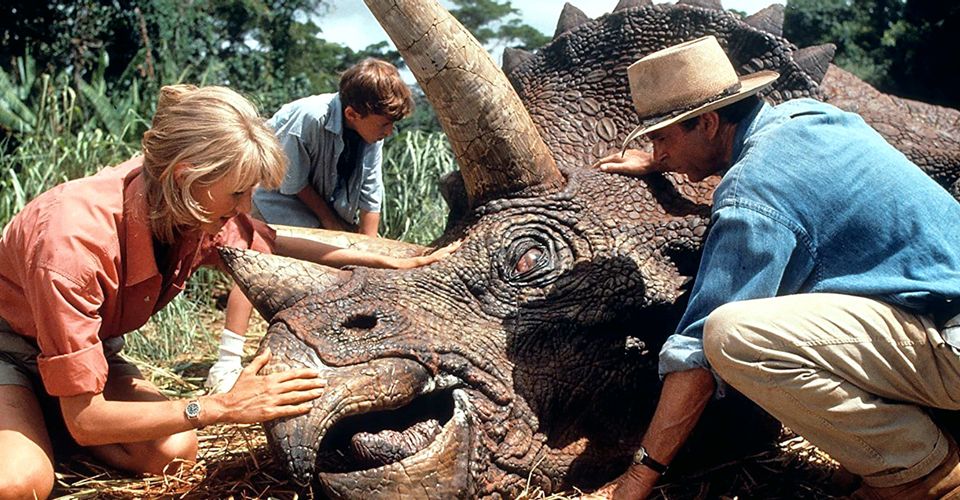
CAST
- Matthew Broderick as Dr. Niko "Nick" Tatopoulos
- Jean Reno as Philippe Roaché
- Maria Pitillo as Audrey Timmonds
- Hank Azaria as Victor "Animal" Palotti
- Kevin Dunn as Colonel Hicks
- Michael Lerner as Mayor Ebert
- Harry Shearer as Charles Caiman
- Arabella Field as Lucy Palotti
- Vicki Lewis as Dr. Elsie Chapman
- Lorry Goldman as Gene
- Doug Savant as Sergeant O'Neal
- Malcolm Danare as Dr. Mendel Craven
- Ralph Manza as Fisherman Joe
- Glenn Morshower as Kyle Terrington
- Chris Ellis as General Hunter Anderson
- Richard Gant as Admiral Phelps
- Clyde Kusatsu as Japanese Tanker Skipper
- Nancy Cartwright as Caiman's Secretary
- Frank Welker as Creature Vocal Effects
- Gary A. Hecker as Creature Vocal Effects
- Kurt Carley as Godzilla (suit performance, uncredited)
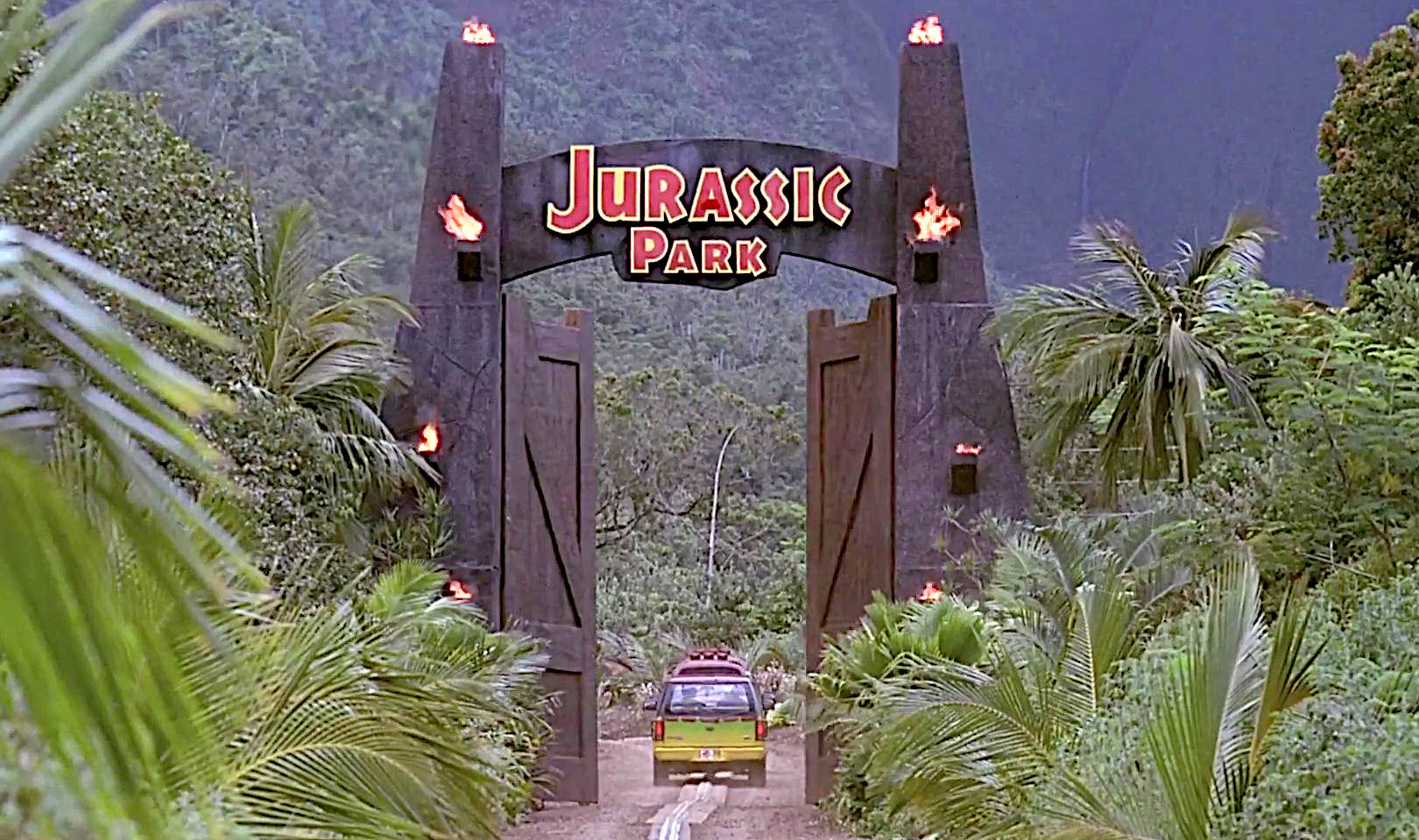
The
King-Kong style giant gates as the tour entry to Jurassic
Park
CRITICS & BOX OFFICE
The Wall Street Journal reported that the film would need to gross $240 million domestically in order to be considered a success. Godzilla was released in the United States and Canada on May 20, 1998, in a record 3,310 theaters. Sony expected the film to gross $100 million during the film's opening weekend, which fell on Memorial Day weekend, expecting to set a new record for the holiday. Ultimately, it would only end up earning $12.5 million on opening day and grossing $44 million during its opening weekend. The film grossed $55,726,951 over the four day holiday weekend, and $74.3 million in its first six days, falling below industry expectations. Its six-day opening gross nevertheless came close to the $74.9 million Memorial Day weekend record previously set by Mission: Impossible in 1996, but fell below the $90 million record set by The Lost World:
Jurassic Park in 1997.
The film's revenue dropped by 59% in its second week of release, earning $18,020,444. For that particular weekend, the film remained in first place as the romantic drama Hope Floats overtook Deep Impact for second place with $14,210,464 in box office business. During its final week in North America, the film was in 19th place, grossing $202,157. For that weekend, Lethal Weapon 4 made its debut, opening in first place with $34,048,124 in revenue. The film went on to top out domestically at $136,314,294 in total ticket sales through an eight-week theatrical run (equivalent to $230 million adjusted for ticket inflation in 2013).
Internationally, the film took in an additional $242.7 million in business, for a combined worldwide total of $379,014,294 (equivalent to $633 million adjusted for ticket inflation in 2013). For 1998 as a whole, the film was the ninth highest-grossing film domestically and the third highest-grossing film worldwide. Despite performing below expectations domestically, Godzilla was a profitable worldwide success, grossing nearly three times its budget. Sony stated that retail sales of consumer products generated $400 million; not only from the 1998 film but from the animated series and the Heisei Godzilla films that Sony acquired at the time.
Godzilla received generally negative reviews from critics. On review aggregator Rotten Tomatoes, the film has an approval rating of 20% based on 148 reviews, with an average rating of 4.50/10. Its critical consensus states, "Without compelling characters or heart, Godzilla stomps on everything that made the original (or any monster movie worth its salt) a classic." Metacritic (which uses a weighted average) assigned
Godzilla a score of 32 out of 100 based on 23 critics, indicating "generally unfavorable reviews". Audiences surveyed by CinemaScore gave the film a grade "B−" on scale of A to F. Criticism highlighted by film critics included the film's script, acting, and directing, while fans targeted the film's reinvention of Godzilla, which included its redesign and departure from the source material.
Roger Ebert from the Chicago Sun-Times gave the film one-and-a-half stars out of four, noting that "One must carefully repress intelligent thought while watching such a film. The movie makes no sense at all except as a careless pastiche of its betters (and, yes, the Japanese Godzilla movies are, in their way,
better - if only because they embrace dreck instead of condescending to it). You have to absorb such a film, not consider it. But my brain rebelled, and insisted on applying logic where it was not welcome." Ebert also pointed out in his review that the characters Mayor Ebert and his assistant Gene were Devlin and Emmerich's jabs at his and Gene Siskel's negative reviews of Stargate and Independence Day. Gene Siskel particularly singled out this aspect, writing "why place us in the movie if you aren't going to have us be eaten or squashed by the monster?" Siskel placed the film on his list of the worst films of
1998. James Berardinelli from ReelViews, called the film "one of the most idiotic blockbuster movies of all time, it's like spitting into the wind. Emmerich and Devlin are master illusionists, waving their wands and mesmerizing audiences with their smoke and mirrors. It's probably too much to hope that some day, movie-goers will wake up and realize that they've been had." Stephen Holden of The New York Times wrote that the film "is so clumsily structured it feels as if it's two different movies stuck together with an absurd stomping finale glued onto the end. The only question worth asking about this $120 million wad of popcorn is a commercial one. How much further will the dumbing down of the event movie have to go before the audience stops buying tickets?"
Michael O'Sullivan of The Washington Post queried, "The question is this: Are the awe-inspiring creature effects and roaring battle scenes impressive enough to make you forget the stupid story, inaccurate science and basic implausibility?" Thoughtfully disillusioned, he wrote, "The cut-rate cast seems to have been plucked from the pages of TV Guide. There's Doug Savant from Melrose Place as O'Neal, a scaredy-cat military man who looks like Sgt. Rock and acts like Barney Fife. There's Maria Pitillo (House Rules) as Nick's soporific love interest, Audrey; The Simpsons' Hank Azaria and Harry Shearer as a wise-cracking news cameraman and superficial reporter; Vicki Lewis of NewsRadio as a lusty scientist. Shall I continue?" Owen Gleiberman writing for Entertainment Weekly thought "There's no resonance to the new Godzilla, and no built-in cheese value, either. For a while, the filmmakers honor the sentimental paradox that seeped into the later Godzilla films: that this primitive destroyer, like King Kong, doesn't actually mean any harm." He opined that the film contained "some clever and exciting sequences", but ultimately came to the conclusion that, "It says much about today's blockbuster filmmakers that they could spend so much money on Godzilla and still fail to do justice to something that was fairy-tale destructo schlock to begin with."
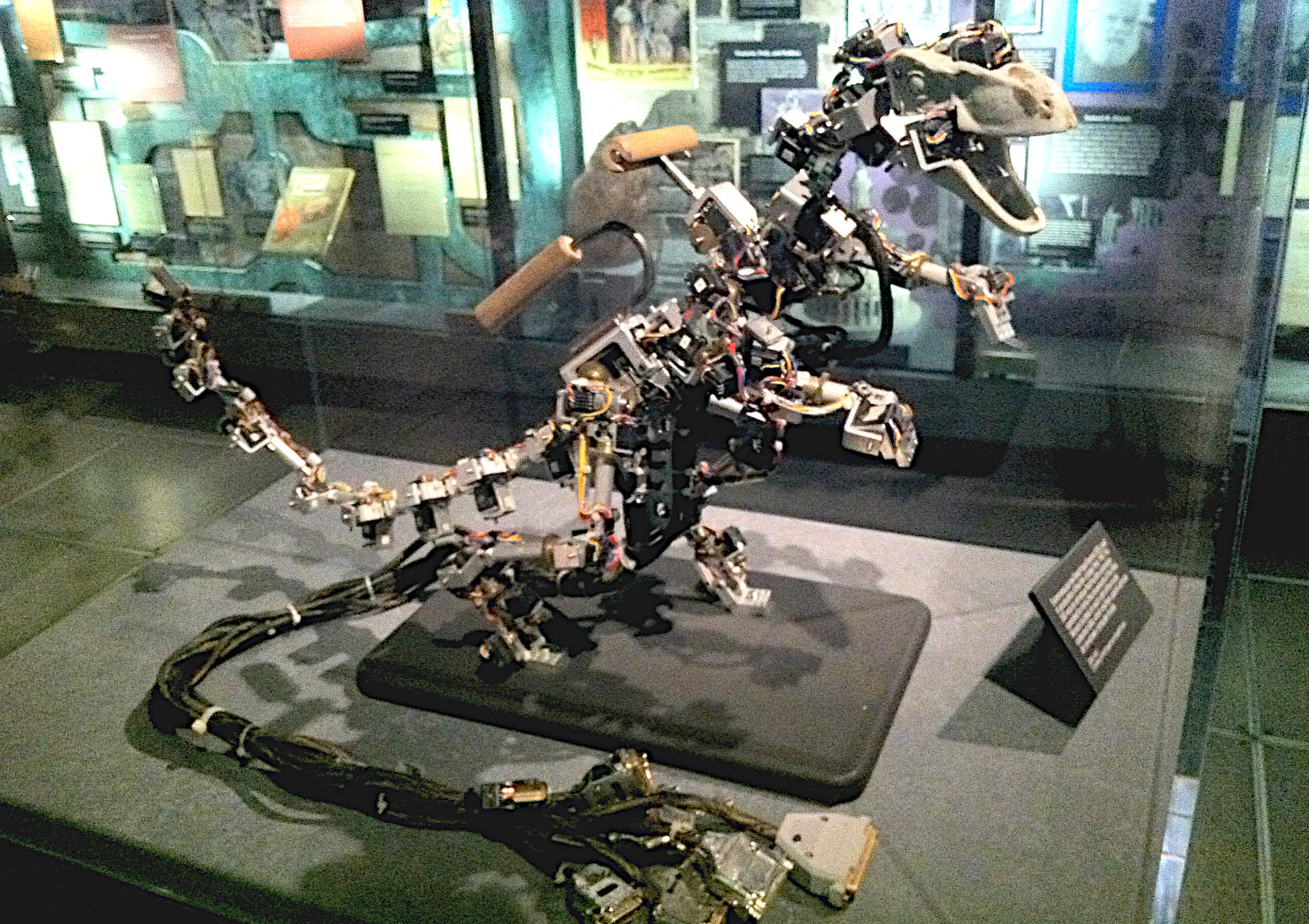
Special
effects animatronic Velociraptor robot
RECEPTION
Review

REFERENCE
https://www
|





